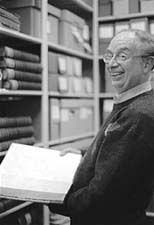

Until recently, many students were missing out on one of Oberlin's most helpful and interesting research facilities. Located on the fourth floor of Mudd, the Oberlin College Archives provides an extensive collection of documents, photos and other records about the school, the city of Oberlin and pretty much anybody who has worked or studied here.
However, after the recent publication of books and even a PBS special which took advantage of the archives' collection, College Archivist Roland Baumann said, "The archives are no longer the best kept secret on campus."

The visibly proud and excited Baumann said, "The archives are the memory of Oberlin College." It has some of the richest documentation for any liberal arts college in the entire country, totaling over 10 million pages and 200,000 photos.
Information on various movements which Oberlin has been involved in, such as the abolition of slavery, black education, co-education, missions and temperance are among those documents. There are also personal documents of faculty and staff, alumni records and even the building files for each College building. He noted, "What is quite striking is the fact that these materials are very much used by patrons."
Some real treasures can be found among the shelves. The collection includes such noteworthy items as pre-Hi-O-Hi yearbooks with ancient black-and-white photos of graduates inlaid in the leather pages. There are even daguerreotypes of professors and students. One of the most exciting of these is a late 1840s picture of three graduates who joined John Brown's antislavery militia in Kansas.
In addition to the photos, there are many interesting documents in the collection. These include the memoirs of Charles G. Finney and records of the notorious investigation of President S. Frederick Starr. The Spalding manuscript, considered part of the Book of Mormon is one of the items of interest beyond the Oberlin community.
Baumann said, "Oberlin College is often a case study of national and regional studies." As a result of this, over 100 scholars each year use some of the historically important documents among the collection to do research. The collection includes an 1834 petition by Oberlin College students urging that the College consider the practicality of admitting black students, and the minutes of a general faculty meeting saying that the school would allow their admission. When Oberlin recently voted on permitting the sale of alcohol in two precincts, journalists used the archives to study records on the temperance movement in Oberlin from 1840 to the present.
After the publication of a book by Nathan H. Brandt entitled The Town That Started The Civil War, which described Oberlin's involvement in the abolition movement, there was a surge in use of the archives. Brandt did some of the research for his book in the archives, and Baumann said that there have been 1,000 inquires from people across the country as a direct result of this book. More recently, an episode of the PBS series The American Experience entitled "America 1900" used a number of photos of China and the Boxer Rebellion from the archives.
In describing the role of the archives in the Oberlin community, Baumann said, "The responsibility of the archives is to preserve and make available the records that are needed for administrative use and academic support." He said that a variety of constituencies are served by it, and that it is one of the busiest archives in the country.
"Those who come to use the archives use it for a full range of research endeavors. We take pride in the fact that holdings are well known and respected not only by academic scholars, but also laymen," said Baumann.
Of course, in addition to the off-campus scholars, writers and historians who use the archives, many students make use of the archives for their own research and papers.
Common topics researched include the way in which Charles Martin Hall discovered the process of producing aluminum or how students did classroom work 100 years ago. Students from a variety of departments also use the archives to study personal papers from some of the first female students at Oberlin to local government documents. According to Baumann, "Students have found visits here quite exciting."
Archives!: College Archivist Roland Baumann. (photo by Beth O'Brien)
Copyright © 1998, The Oberlin Review.
Volume 127, Number 11, December 4, 1998
Contact us with your comments and suggestions.